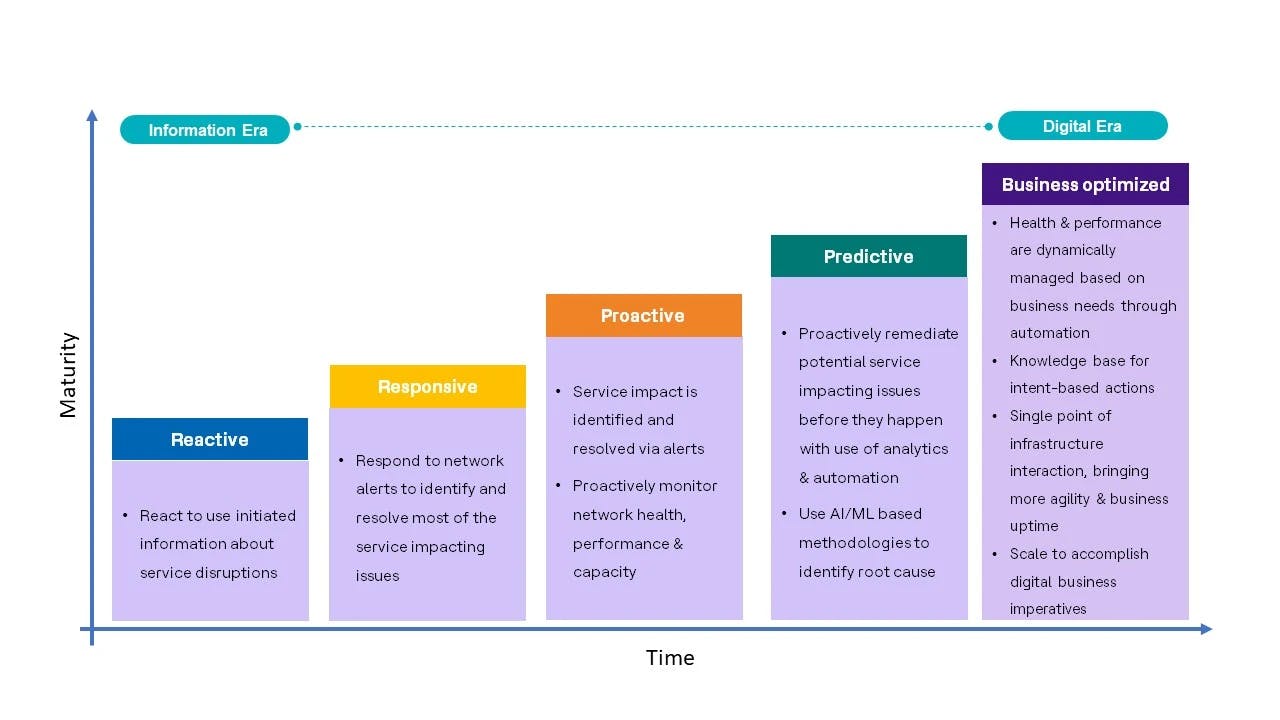In the era of Industry 4.0, enterprises face myriad challenges in operating and maintaining their networks. These include ensuring that their networks are aligned with the changing business dynamics at all times while delivering a seamless experience to employees and omnichannel customers.
The complexity of modern networks necessitates the adoption of automation to keep pace with the evolving landscape. This wasn’t the case in the past, however, as networks were limited to routers, switches, firewalls, load balancers and server closets. Today, we have IoT, MEC, multi- and hybrid-cloud computing, microservices, B2B2X convergence and edge connectivity. These technologies have expanded network boundaries and made the core network fabric complex and diverse.
The introduction of remote work and bring-your-own-device (BYOD) policies with the proliferation of IT-OT convergence has further complicated the network infrastructure.
Given the scale and intricacy of modern networks, automation offers solutions for already exhausted NetOps teams.
NetOps evolution for an enterprise

Traditionally, NetOps has been manually driven and reactive in nature. As a result, it has always been overwhelmed with firefighting and not aligned with long-term business strategy.
With the adoption of network automation — that sees the majority of NetOps automated through AI/ML — enterprises can move to a business-optimized NetOps that boasts of an intent-based and self-healing network aligned to their business strategy.
Network automation itself has progressed beyond its rudimentary stages of robotic process automation (RPA), which focused on automating routine, high-volume and less intelligent network operations to more cognitive intelligence-based automation.
The network automation journey: From “as-is” to “to-be” transformation
The key benefits of a proper network automation strategy include streamlined operations, improved efficiency and reduced downtime through automated provisioning, configuration and troubleshooting. A network automation journey enables rapid adaptability to changing demands, swift deployments and configuration changes to ensure faster time-to-market.

The mere adoption of an automation framework or tool doesn’t guarantee desired results. Also, the results don’t show up overnight or even over a fortnight. Adoption of network automation and the associated way of working is a journey that takes place over several months, and only those enterprises that remain committed to their long-term goals reap the benefits.
Advancing operational excellence
Apart from automating routine NetOps such as configuration and change management, incident and event management, scheduled backups and configuration upgrades, network automation is increasingly being used to handle much more complex use cases. These include:
- Network design while enhancing design workflows
- Network services provisioning and interconnection provisioning
- Traffic engineering
- Plug-and-play device provisioning
- Network troubleshooting and guided remediation
- Network optimization
- Automated diagnostics and outage prevention
How to start your network automation journey
Beginning your network automation journey might look daunting, but your efforts will pay rewards sooner than later. Here are a few tips to help you navigate this path seamlessly:
- Start small: Start automating small network activities in the beginning, such as automating the execution of basic health check commands. This will ensure minimal impact and a bottom-up learning curve.
- Inculcate a security mindset from the beginning: Include a backend security strategy in your automation posture, as it can get tedious to implement security standards at a later stage.
- Governance mechanism: Set up a reporting mechanism with key stakeholders and define relevant KPIs to monitor them closely at periodic intervals. This ensures your network automation journey is always on track and teething issues are addressed as early as possible.
- Introduce approval mechanisms: An approval process is essential during the initial stages of your network automation journey. This helps your team build confidence and retain some control during the learning curve. Once you see the benefits, the automated processes can run in an autonomous fashion.
- Ensure the right skillsets for your team: Training your team with relevant literature and demos is essential. In its absence, you can go off track and derail your efforts.
Conclusion
In the realm of enterprise networks, technological advancements are revolutionizing the way networks operate and thrive. By embracing automation, organizations can overcome challenges, unlock efficiency gains and enhance network performance.
Leveraging AI/ML and intent-based networking empowers organizations to adapt to evolving network landscapes and proactively address their network issues. That is the reason network automation will remain a critical pillar for building robust, agile and secure networks as the digital landscape evolves.
To take the discussion forward, please write to us at Contact.NGN@hcltech.com.




